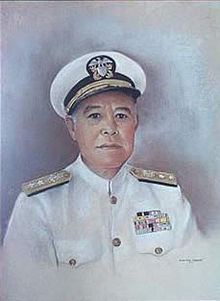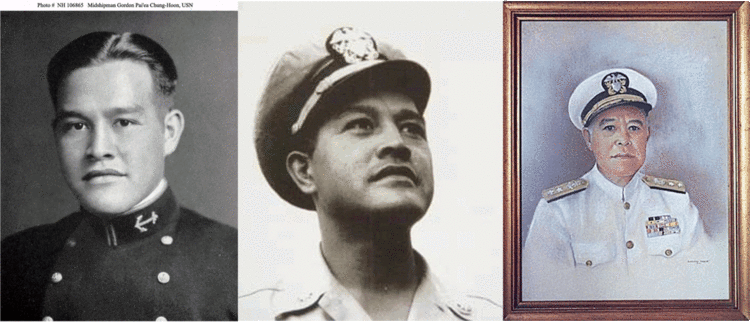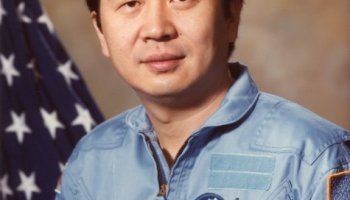Years of service 1934–1959 | Name Gordon Chung-Hoon | |
 | ||
Born July 25, 1910Honolulu, Hawaii ( 1910-07-25 ) Education | ||
Gordon Paiʻea Chung-Hoon, (Honolulu, Hawaii, July 25, 1910 – July 24, 1979) was an admiral in the United States Navy, who served during World War II and was the first Asian American flag officer. He is a recipient of the Navy Cross and Silver Star for conspicuous gallantry and extraordinary heroism as commanding officer of USS Sigsbee from May 1944 to October 1945.
Contents

Life

Chung-Hoon was born in Honolulu, Hawaii on July 25, 1910. His father, William Chung-Hoon Jr., a Chinese-English-Hawaiian, was a county treasurer and his mother Agnes Punana, a Hawaiian, was a member of the Kaahumanu Society. Chung-Hoon was the fourth of five children born to his family. He graduated from Punahou School in 1929.
Military career
Chung-Hoon attended the United States Naval Academy and graduated in May 1934, becoming the first Asian American, U.S. citizen graduate of the academy. While a student he gained national prominence as the football team's halfback and punter, and in 1934 starred on the team that broke an 11-year winless streak against the Army team. In 1958 Sports Illustrated's Silver Anniversary All-American issue featured Chung-Hoon as one of its 1933 football stars.

After graduation Chung-Hoon served in a number of lower-level officer positions in the navy, including as a lieutenant (junior grade) on the USS Dent.
World War II
Chung-Hoon served on the USS Arizona as a lieutenant, but was in Honolulu on a weekend pass during the attack on Pearl Harbor. Chung-Hoon heard the attack from Honolulu and attempted to return to his ship but was delayed by roadblocks and traffic jams. By the time he reached the Arizona the ship had already exploded and sank.

After the sinking of the Arizona, Chung-Hoon served as a naval liaison officer with coastal artillery before becoming executive officer on a destroyer in 1942, working convoy details in the Atlantic. He also served on board the USS Honolulu.
From May 1944 to October 1945 Chung-Hoon commanded the destroyer USS Sigsbee. In the spring of 1945, Sigsbee assisted in the destruction of 20 enemy planes while screening a carrier strike force off the Japanese island of Kyūshū. On April 14, 1945, while on radar picket station off Okinawa, a kamikaze crashed into Sigsbee, reducing her starboard engine to five knots and knocking out the ship's port engine and steering control. Despite the damage, then Commander Chung-Hoon kept his antiaircraft batteries delivering "prolonged and effective fire" against the continuing enemy air attack while simultaneously directing the damage control efforts that allowed Sigsbee to make port under her own power.
The damage had been severe enough that Admiral William Halsey, Jr. told Chung-Hoon to scuttle the ship. However, Chung-Hoon declined to do so, telling the admiral "No, I have kids on here that can't swim and I'm not putting them in the water. I'll take her back."
The next day Chung-Hoon led a burial at sea for the dead. One crewmate said of Chung-Hoon during the burial, "I often remember that the only man tough enough not to duck, was also the only man tender enough to cry."
For Chung-Hoon's service aboard the Sigsbee he received Navy Cross and Silver Star for conspicuous gallantry and extraordinary heroism.
During the war, two of Chung-Hoon's brothers served in the Army in the Pacific theater.
Korean War
From August 16, 1950, to March 7, 1952, Chung-Hoon commanded the USS John W. Thomason (DD-760) during the Korean War. Under Chung-Hoon's command the destroyer operated as part of the 7th Fleet, patrolling off the coast of Korea and taking part in gun bombardments.
Post-military
He retired in October 1959 as a rear admiral. He was appointed to be the Director of the Hawaiian Department of Agriculture, and died in July 1979.
Namesake
The Arleigh Burke class destroyer USS Chung-Hoon is named for him.
Navy Cross citation
The President of the United States of America takes pleasure in presenting the Navy Cross to Commander Gordon Paiea Chung-Hoon, United States Navy, for extraordinary heroism and distinguished service in the line of this profession as Commanding Officer of the Destroyer U.S.S. SIGSBEE (DD-502), a unit of an Advanced Picket Group, in action against enemy Japanese forces in the vicinity of Okinawa, Ryukyu Islands, on 14 April 1945. Although his ship suffered major damage when struck by an enemy plane and all power was lost, Commander Chung-Hoon coolly carried out defensive maneuvers and directed his anti-aircraft batteries in delivering prolonged and effective fire against the continued heavy enemy air attack. Afterwards, he supervised damage-control procedure which resulted in his ship being made sea-worthy for a safe return to port under its own restored power. Commander Chung-Hoon's gallant fighting spirit, courage and unwavering devotion to duty were in keeping with the highest traditions of the United States Naval Service.
